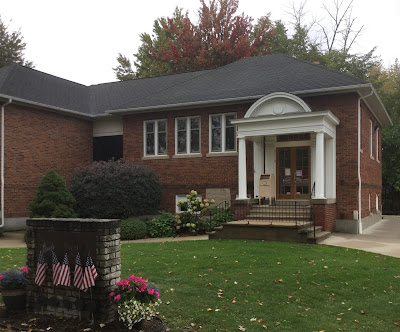The temperatures have become more amenable, climbing into the sixties for the first time in a week. It is much easier to crawl out of the tent when it is fifty degrees, rather than forty. It is no longer November, but rather Biketober, the best month for cycling. Along with the warmer temperatures, the sky has cleared. It is always good to be on the bike, but all the more so when it is bright and sunny.
It didn’t even dampen my spirits to be passing through Flint, a symbol of industrial decay and government not concerned with the welfare of its citizens. Even before it’s disastrous drinking water crisis when the mayor chose to change the city’s water source from Lake Huron to much cheaper, heavily polluted river water, Flint had the image of a downtrodden city where one wouldn’t want to live, partially thanks to Michael Moore, who grew up in the neighboring town of Davison. His documentary “Roger and Me,” about his attempt to interview the CEO of General Motors so he could give him a piece of his mind, established Flint as the epitome of a city strangled by corporate-firstism, at least in the mind of Moore.
Biking through the city, I couldn’t distinguish it from Gary, Indiana or Port Huron, or other cities in serious decline. There wasn’t much traffic, pedestrian or motorized. I figured it would be a good place to find a cheap motel, as I was in need of a shower after six nights of wild-camping. TripAdvisor offered a handful for fifty dollars or less, most with breakfast included. None mentioned that breakfast had been cancelled due to Covid, as I learned when I checked in, a huge disappointment. Motel breakfasts may not be anything special, unless they are accompanied by a do-it-yourself waffle-maker, but they are generally self-serve. I can often eat enough to get me through the day.
Besides a shower, I was also in need of a tire, as my rear one had surprisingly shown spots of the tread having worn through. I had replaced it in Columbus on my last trip, a little over 2,000 miles ago. I can generally count on getting 2,500 miles on my rear tire and twice that on the front. I had expected it to last this trip.
Having to replace it wasn’t all bad, as it allowed me to search out a bike shop. There seemed to be only one in Flint, five miles south of the city center—Assenmacher Cycling Center, named for the owner, Matt, who had at one time been a frame-builder. When demand declined for custom frames, he turned his urge for welding to making lamp shades and other objects from bike parts.
The possibilities are endless, as was demonstrated by the yard full of bike art I passed by earlier on this trip, and, of course, by all the concoctions I encounter along The Tour de France route. Matt is an ardent racing fan and had gotten to The Tour de France a couple of times, including 2004 when we were both among the tens of thousands packed on L’Alpe d’Huez for the only time it was a time trial in The Tour, which Armstrong won on his way to his sixth consecutive Tour victory. Matt was wearing a well-faded Postal Service baseball cap from that year. In hand was another of the arty bike objects scattered around his large shop—a pen and pencil holder made from bike chains.
His artistic whims went beyond bicycle parts. He had arranged a couple of piles of rocks in front of his shop as well. He didn’t really need to draw attention to his shop as he acknowledged he is about the only one in the area. “There might be one downtown,” he said, “But I’m not sure about that. There were five Schwinn shops twenty-five years ago and several others, but they’re all gone. There is one in Davison to the east of the city.”
It was very community-oriented, open on a Sunday. The Carnegie portrait resided in a corner above the original wooden book shelves.
The library was located on the busy four-lane highway, Main Street, that passes through the center of the town. Entry is now through the small addition on its backside, away from the hubbub of the traffic.
In this time of Covid, as in all the libraries I’ve stopped at, plexiglass surrounded the librarians and the drinking fountains were closed.
Twenty miles north of Lapeer in Marlette is another later-Carnegie, also built in the 1920s. It was the last in the Midwest to receive a grant from Carnegie and the second to the last in the country. It too was a modest, but distinguished-looking, red-brick building, as Carnegie preferred. He didn’t endorse the ornamentation of the early libraries—columns and domes and such. His usual ten thousand dollar grant went further a decade or two before these libraries built in the ‘20s and could provide for such excesses.
It had an addition to its side, more than doubling its size. A plaque out front gave the false information that it was one of fifty-three Carnegies in Michigan, confusing the number of grants to the state with the number of libraries. Carnegie gave grants to fifty-three towns and cities in Michigan, with the grant to Detroit providing for nine libraries—its main library and eight branches—bringing the total of Carnegies in Michigan to sixty-one. I’ve gotten to all but ten of the fifty still standing, each a marvel. Six more await me on this trip and then four more in the far west of the Upper Peninsula.











1 comment:
Welcome back to Michigan, George. Sure wish we'd known you would be passing through Grand Blanc, would love to have you spend the night. Very glad you had a chance to meet Matt Assenmacher. D.F.Pope, United Teachers of Flint - Retired
Post a Comment